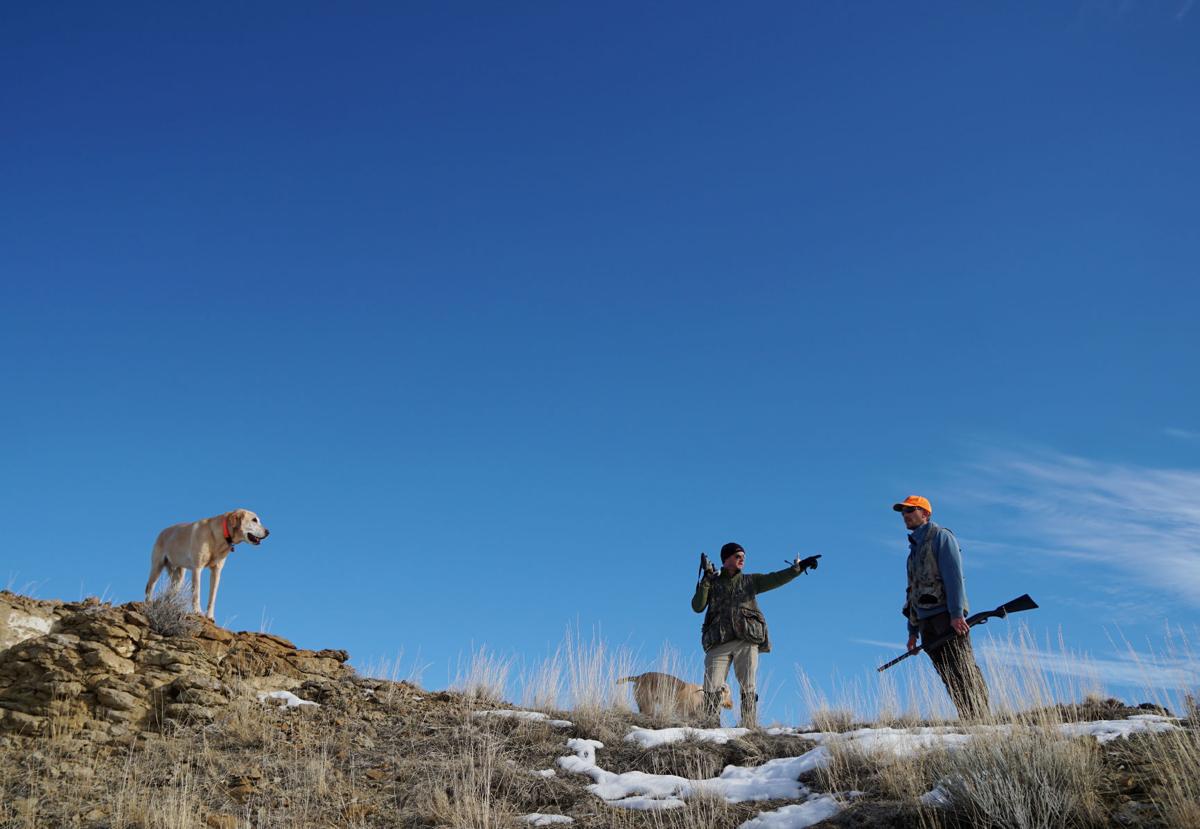BIGHORN BASIN, Wyo. — We hadn’t been out of the truck for five minutes when we saw the tiny birds skittering up through the sagebrush-covered hillside. Their bodies blended into the landscape, gray among a sea of brown and white.
If we’re being honest, in this stretch of rocks and cliffs, they walked almost as fast with their 4-inch long legs as we were stumbling over bushes. But we gained nonetheless.
“This could get fast and furious,” said Casper hunter and wildlife biologist Justin Binfet.

Two hunters walk along cliff walls recently in Wyoming's Bighorn Basin looking for chukars. The small partridge was introduced into North America from Asia, and now persists as a gamebird available for hunting until the end of January.
Christine Peterson, Star-TribuneWe were in a canyon somewhere in Wyoming. Where, exactly, I’m sworn to secrecy. It was one of the conditions of going.
My husband, Josh, and I had been chukar hunting before, but only a couple times with limited success. They can be hard birds to find and require hunting in rugged canyons.

A Labrador retrieves a chukar shot recently in the Bighorn Basin.
Christine Peterson, Star-TribuneBy January, when winter has its frigid fingers clenched around the state, few people think about hunting. Most big game seasons are over, and the chance to hunt pheasants and fall turkeys has passed. Spring turkey hasn’t started yet. Duck and goose hunters are often the only ones braving the cold.
For hunters, it’s often a time of gun cleaning, ice fishing and hunkering down with dreams of crisp mornings when elk bugles rip through the air and mule deer bucks sneak through the woods.
But for the ambitious and energetic, Wyoming offers one more chance to wear yourself out carrying a shotgun. While this year isn’t a bumper chukar crop, they’re there, and worth chasing.
Chukars, like the more flamboyant pheasants and the similarly sized Hungarian partridge, aren’t native to Wyoming. Chukars evolved in Asia and the Middle East. They’re smaller than a football and tough as nails.
They eke out a living in steep canyon country of the Bighorn Basin and central Wyoming. The Wyoming Game and Fish Department doesn’t grow and release them, so they reproduce naturally.

The Wyoming bag limit on chukars is five each day, but their speed and skittishness makes them a difficult quarry.
Christine Peterson, Star-TribuneTheir populations fluctuate depending on snow depth. They starve if they can’t find bare ground in the winter, and their chicks don’t hatch if the spring is too wet and cold.
They feast on cheatgrass where it pokes through the ground on warm, south-facing slopes and other green shoots and leafy forbs.
Those south-facing slopes are where we found them in the aforementioned secret spot in a rocky, winding canyon on a windy day in mid-January. The covey we chased dropped down into gullies and popped back up yards away. We called to the dogs over 30 mph winds to simultaneously find the birds while not straying so far away they would scare the birds into the air before we were close enough to shoot.
Maybe they heard us whisper-shout to the dogs in a voice generally reserved for chiding children in crowded theaters, or maybe they got tired of running. Either way, the covey of birds exploded into flight and glided toward the depths of the canyon.
One second they were scampering away as we gained on them. The next, they were gone.
We paused for a second to catch our breath.
Chukar hunting, I realized that day, is similar to racing a marathon in snow-covered badlands while carrying a shotgun and wearing a regrettable number of layers. Each hunter is only allowed to shoot five chukars a day. I wasn’t too worried about reaching our limit.
Even when bird numbers are strong, the combination of their skittish disposition and bullet-like speed make them a tricky quarry.
But hunting is rarely about taking something home.
It’s about hours spent trudging through rugged plains that always seem to change. It’s about herds of pronghorn and impressive mule deer bucks. It’s about countless hawks and eagles suspended effortlessly in the relentless winds.
We ultimately found more coveys, and brought a couple birds home.
Even if the numbers aren’t strong, or the winds are, fight the impulse to nestle on that couch and dream of fall.
Chukar season lasts until the end of January in Wyoming. It’s worth a shot.



